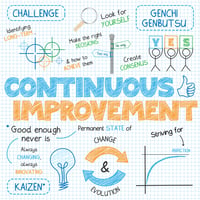A supplier audit is one of the most effective ways to ensure your suppliers adhere to quality...
Cutting Costs or Cutting Corners? The True Cost of Skipping Supplier Audits.
The cost of quality is difficult to measure, and with life science manufacturers being pushed to cut costs while increasing the speed of production, it seems that the ever-meticulous qualitydepartment is one of the first to suffer. Quality teams, tasked with reducing expenses, are reassessing the risk levels of their suppliers, seeking ways to justify reducing the criticality of suppliers and potentially lowering audit requirements to save on costs.
But what is the long-term cost of avoiding audit requirements? Could a risk assessment adequately replace an audit and save valuable operating capital? What is the likelihood of increasing future spending if the risk-based approach to compliance isn’t handled correctly?
Outsourced Manufacturing: A Necessity and a Risk
In the medical device and pharmaceutical industries, the complex nature of product development and the rapid evolution of medical devices often demands the use of many suppliers. Given the extensive range of materials and components needed for these complex medical devices, bringing all manufacturing processes in-house is impossible for most companies. Therefore, outsourcing has become an essential practice, but relying on third-party manufacturers introduces significant risks. Any deficiencies in the production of externally sourced products can damage a company’s reputation, lead to costly recalls, and, more detrimentally, harm patients.
Risk-Based Approach to Ensuring Supplier Quality Compliance
One of the primary responsibilities of quality teams is to manage and regularly evaluate their approved supplier list (ASL) to ensure that all suppliers comply with FDA regulations, as applicable, and other international standards. Many medical device companies have turned to a risk-based approach to supplier management to save time, reduce costs, and focus resources on the most critical suppliers rather than those presenting minimal risk. Through a risk-based approach, companies assess the criticality of a supplier based on the impact of their products on the quality or availability of the final product. Determining the criticality of each supplier then leads to selecting the appropriate audit type and audit frequencies. High-risk suppliers require the most detailed, most frequent audits and lower-risk suppliers require less oversight.
However, in recent years, increasing pressure to reduce costs has led many quality managers to reconsider the criticality of their approved suppliers and downgrade suppliers to decrease their audit frequency. While this may offer short-term savings, it can also introduce risks by limiting oversight, potentially overlooking critical issues that could escalate into costly problems in the future.
The Use of Risk Assessments in Meeting Quality Requirements
A risk assessment is as it sounds: an evaluation and detailed documentation of the risk a supplier poses. These assessments are not pass or fail, rather, they are an opportunity to document, in granular detail, as much risk as can be found for a supplier or potential supplier. When combined with audits, risk assessments can help determine the frequency and type of audits required for each supplier.
Once risk is evaluated, companies should implement actions to reduce or avoid risk by conducting a survey or audit. If not carefully managed, relying too heavily on risk assessments without comprehensive audits can lead to gaps in oversight. Even low-risk suppliers canintroduce significant issues if their operations are not evaluated at regular intervals.
A Drip Before the Flood: The Risk of Overlooking Small Suppliers
Imagine there’s a home with tiny faucet leak—a small drip that doesn’t seem worth worrying about. The homeowner notices the leak, but it’s minor enough that fixing it seems like more trouble than it’s worth. Over time, the seemingly insignificant drips add up until the water begins to pool. As the water pools, seeping into the walls and floors, it causes damage to the infrastructure and creates mold in the home. If left unattended, what was once a small leak can lead to the collapse of an entire wall, or flooding, resulting in thousands of dollars of damage. That small, once thought to be insignificant drip, would have been worth the trouble to fix in the first place.
The same is true of a company’s suppliers. Once a risk assessment is done, and a supplier is determined to have an insignificant enough impact on the final product that an audit isn’t needed, a company may choose to avoid the trouble and cost of auditing that supplier. Not auditing them for a time may be appropriate based on the risk. But what are the actual cost savings if a quality event occurs as a result of no audits being conducted? What is the cost of that tiny, insignificant “drip” when the walls and floors begin to flood?
The Cost of Non-Compliance
The medical device industry allocates a significant portion of its budget to quality-related costs, estimated at 6.8% to 9.4% of annual revenue. This amounts to approximately $26 - $36 billion each year. Notably, one-third of these costs are dedicated to ensuring quality through rigorous testing, process validations, and comprehensive supplier audits. These investments are essential to maintain high standards and prevent defects before products reach the market.
However, the remaining two-thirds—approximately $24 billion annually—is the direct cost of poor quality. These costs can arise from product recalls, rework, scrap, warranty claims, and the labor cost of remediating the failure. While these figures are staggering, it’s important to note that they don’t include the often more severe indirect costs. Indirect costs, although harder to quantify, involve damage to a company's reputation, loss of market share, stock devaluation, and legal expenses. These can have a more significant long-term impact than the direct costs alone.In fact, in the medical device industry, a single major recall can lead to a revenue decline of 10-30% in the subsequent years.
With the growing complexity and fast-changing developments of the life sciences comes an increased cost from quality events. This annual cost increase is projected to be around 1.5%, translating to an additional $5 billion each year just to address non-conformities.
While audits and other proactive quality measures may incur upfront costs, they are crucial for preventing costly non-compliances, and significantly reducing overall expenses. Implementing strong quality practices—distinct from merely meeting regulatory standards—could recover more than 3% of industry revenues, offering an annual cost savings of approximately $11 billion.
How Medpoint Can Help:
Several practices are correlated with good quality outcomes: robust product and process controls, strong operational maturity, developed quality systems, thoughtful audit scheduling, and significant and impactful quality culture. Consulting with quality experts to achieve these desired outcomes is sure to save time and money in the long run.
Medpoint provides experienced consultants who can impartially assess your suppliers to determine the true risks they pose. Additionally, our team of global auditors is ready to carry out comprehensive supplier audits to meet all your quality compliance needs.
Let Medpoint fix the leaks before your house is flooded.
References:
The Business Case for Medical Device Quality
Audits VS Assessments and Why They are Not the Same Thing
Capturing the Value of Good Quality in Medical Devices
Author: Rachel Henderson, Project and Document Control Coordinator



